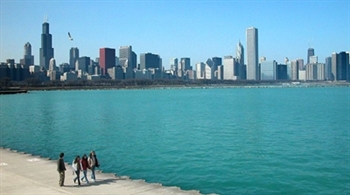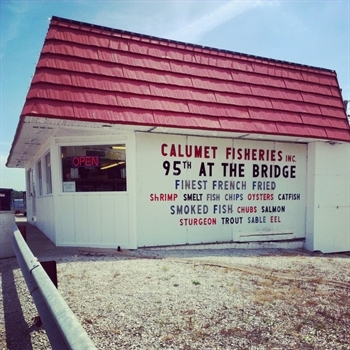
WBEZ
We have great rivers, Chicago, so join us in Great Rivers Chicago!
“Chicago’s second lakefront.” That’s a line we often hear about the potential for Chicago’s rivers (and when I say “rivers,” I mean all of them: the Chicago and all its reaches, plus the Calumet system and a stretch of the Des Plaines) to be cleaner, more active, more productive and more than they are today. And for good reason. Chicago has 28 miles of lakefront, but more than 100 miles of riverfront. Think about that. Arguably this is a river city that sits on a lake, and always has been. It was the rivers, after all, that enabled Chicago to become Chicago, rather than just another pretty lakefront town.
Which is why we at the Metropolitan Planning Council (MPC) are so excited about the City’s new Great Rivers Chicago initiative. Over the next 15 months, we’ll be working with the City of Chicago, Friends of the Chicago River and a host of other leaders and experts to create a unifying, long-term vision for our rivers. And of course, we’ll need input from you, your friends, your family and neighbors. Because our rivers deserve a little love.

The Lake Michigan shoreline we experience is the result of decades of visioning, planning and capital investment. Let's pour that same love into our rivers.
To be sure, I love Chicago’s lakefront. Who doesn’t? The water, the trail, the vistas, the public open space, the air. They’re great. So great that it’s hard to imagine for many people that we used to dump our wastewater and stormwater straight into Lake Michigan, or that railroad tracks and major roads were once as prominent as our current parks, or that it was ever anything other than what it is. But it was. And then we developed a unifying vision, followed by supporting policies, ordinances and protections. We planned capital improvements, developed programming and marketed it. I’d say Chicago’s lakefront is what it is today not because of the lakefront itself, but because of the political, emotional and capital investments of many Chicagoans over many decades (and it’s still a work in progress).
Chicago is a river city that sits on a lake.
And now it’s time (perhaps past time) to do that with our rivers too. Our rivers are cleaner than the once were, more active, more desirable. They are not what they used to be, but they’re also not what they will be, or could be, in the future. For everything that’s great about Chicago’s lakefront, you can’t exactly live or work right next to it. Far more neighborhoods have access to a riverfront than the lakefront, and my guess is that more people interact with the rivers in any given day (even if that means passing over them…or under them).
Our rivers can connect communities, businesses and people in ways the lakefront cannot. River-oriented development? We have it and can have more. A continuous path along the Chicago or Calumet? It’s possible, and even underway with the Cal-Sag Trail. Cleaner water? It’s a work in progress too. Transit on the rivers? The water taxi is off to a promising start.

Transit on the river? Why not? Even with a relatively limited service area and schedule, the Chicago Water Taxi is proving that folks will take a boat to work.
Let’s be clear, our rivers have come a long way. Since the U.S. Clean Water Act in the mid-1970s the river system has steadily improved. New homes and businesses, rowing centers and river trails, waterfront bars, parks, transit and industry have sprung up, and the rivers now serve as home for more than 70 species of fish, as well as turtles, beavers, muskrats and more.
And change continues to happen. In recent years we’ve seen the Riverwalk, Ping Tom Park and boat houses on the Chicago River come to fruition, with new planning starting for Lathrop Homes and Altgeld Gardens, both riverfront communities. Water quality continues to improve. We have way more watercraft on our rivers than in eras past, but increasingly in the form of kayaks and tour boats. A big group of funders created the Chi-Cal Rivers Fund to make targeted investments. Each of these have signaled progress, yet many reasons compel us to take a step back from these positive initiatives and establish a unifying vision, action agenda and policy changes.
More rain is straining our ability to manage stormwater, impacting water quality and increasing flooding. All those kayaks and tour boats? They’re out there with barges that still carry huge loads, and our “rules of the road” need a little work to manage all those users. Demand for riverfront real estate is booming in some neighborhoods, and essentially nonexistent in others. A range of aquatic invasive species use our rivers as pathways between the Great Lakes and Mississippi River, forcing some serious rethinking about how the system works. Access to open space or public amenities along the rivers is inconsistent, where it exists at all.
For the long-term benefit of the Chicago region’s economy and environment, we need to identify the full range of benefits we wish to receive from our rivers, those that residents and other users will demand in the coming decades. We can then devise an action plan to get us there in a measured and thoughtful way. That’s what Great Rivers Chicago is setting out to. It’s a big task, and we need all hands on deck.

Abby Crisostomo
Award-winning Calumet Fisheries is one of the few riverfront dining options available outside downtown Chicago.
MPC, working with a Leadership Commission, a resource group of technical experts and Friends of the Chicago River, will rally support from the public and private sector, solicit input from the broadest possible array of regional stakeholders, engage the broader public in new, creative and meaningful ways, and facilitate a citywide visioning process. Once the vision for Chicago’s rivers is established, known and embraced, these leaders will then work with the public and private sector to implement it through subsequent planning, policy change and investments.
The first thing everyone can do (and please do do it!) is take the survey on the Great Rivers Chicago web site, and leave us your contact information. That’ll help us collect baseline conditions on what people think (or don’t think) about our rivers. Then, throughout the rest of 2015 and into 2016, we’re planning lots and lots and lots of ways for people to get involved. Interviews. Focus groups. Paddling trips. Picnics. Pop-up barge restaurants. Photo contests. Placemaking activations. Maybe even bridge parties (ever played bridge on a bridge?). Long story short, we want to talk to you, whether you use the rivers all the time, work on one, live by another or have never even given Chicago’s rivers a passing thought.
The only way we get this right is with Chicago residents like you involved, because with more than 100 miles of riverfront, I know this can be a system for every use, every user and every community. We have great rivers, Chicago, so join us in Great Rivers Chicago.